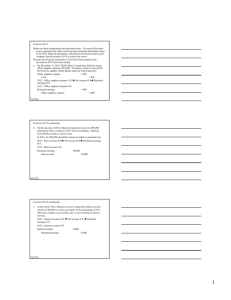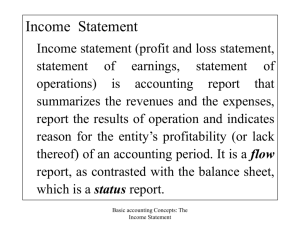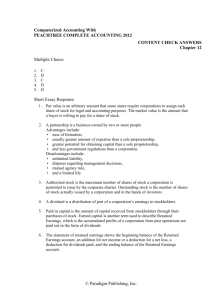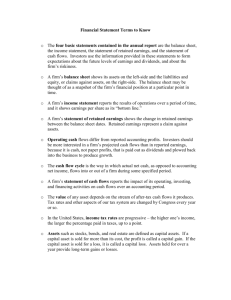Problem Set 1 Solution a) BSE Table
advertisement
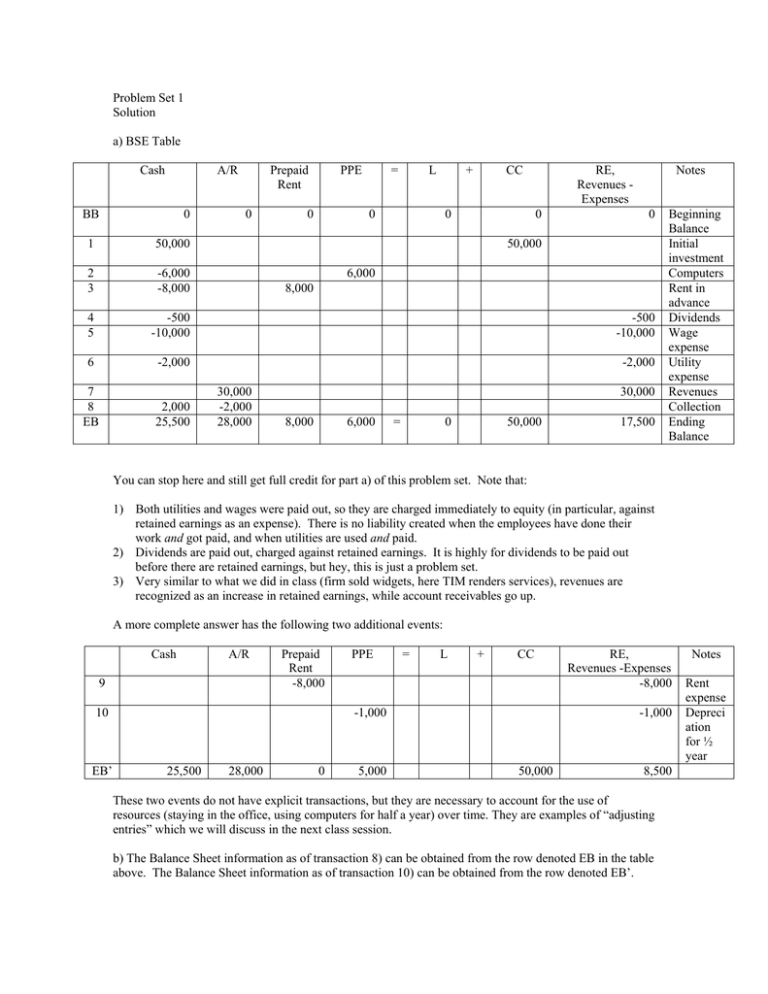
Problem Set 1 Solution a) BSE Table Cash A/R BB 0 Prepaid Rent 0 PPE 0 = L + 0 CC 0 RE, Revenues Expenses 0 Notes 0 1 50,000 50,000 2 3 -6,000 -8,000 4 5 -500 -10,000 -500 -10,000 6 -2,000 -2,000 7 8 EB 2,000 25,500 6,000 8,000 30,000 -2,000 28,000 30,000 8,000 6,000 = 0 50,000 17,500 Beginning Balance Initial investment Computers Rent in advance Dividends Wage expense Utility expense Revenues Collection Ending Balance You can stop here and still get full credit for part a) of this problem set. Note that: 1) Both utilities and wages were paid out, so they are charged immediately to equity (in particular, against retained earnings as an expense). There is no liability created when the employees have done their work and got paid, and when utilities are used and paid. 2) Dividends are paid out, charged against retained earnings. It is highly for dividends to be paid out before there are retained earnings, but hey, this is just a problem set. 3) Very similar to what we did in class (firm sold widgets, here TIM renders services), revenues are recognized as an increase in retained earnings, while account receivables go up. A more complete answer has the following two additional events: Cash A/R 9 Prepaid Rent -8,000 10 EB’ PPE = L + CC -1,000 25,500 28,000 0 5,000 RE, Revenues -Expenses -8,000 -1,000 50,000 8,500 These two events do not have explicit transactions, but they are necessary to account for the use of resources (staying in the office, using computers for half a year) over time. They are examples of “adjusting entries” which we will discuss in the next class session. b) The Balance Sheet information as of transaction 8) can be obtained from the row denoted EB in the table above. The Balance Sheet information as of transaction 10) can be obtained from the row denoted EB’. Notes Rent expense Depreci ation for ½ year My answers below will be based on including events 9) and 10). You will get full credit if your answers are based on transactions up to 8) only. Balance Sheet of TIM, Inc As of December 31, 2000 Assets: Cash A/R 25,500 28,000 Liabilities PPE Total Assets 5,000 58,500 Equity Contributed Capital Retained Earnings Total Liabilities and Equity 0 50,000 8,500 58,500 Since the balance sheet is a snapshot, it is important to label it as such: “as of December 31, 2000” c) Income Statement For the period July 1, 2000 through December 31, 2000 Revenues Design services Expenses Wages Utilities Rent Depreciation Net Income 30,000 -10,000 -2,000 -8,000 -1,000 9,000 Note that dividends are not part of the Income Statement. Also, since the income statement is supposed to denote what happened between two snapshots, it is important to label it appropriately: “for the period from July 1, 2000 though December 31, 2000”. c) Looking at the cash column, cash inflow is 52,000, and cash outflow is 26,500. However, we exclude the 50,000 inflow because it is a financing (raising capital) transaction, not directly related to operations. We also exclude 500 of dividends from cash outflows because dividend payments are also financing. You will learn later on that long-term investments like PPE do not properly belong to operations, but "investing". For now, let's ignore this detail. d) Profits equal 9,000, even though net cash flow (operations and investments) is 2,000 – 26,000 = -24,000. TIM is still profitable despite a negative cash flow. TIM has Accounts Receivables of 28,000, and a computer worth 5,000, both of which have the capacity to generate cash in the future. e) Permanent accounts are cash, accounts receivables, PPE, contributed capital and retained earnings. Note that even though prepaid rent got zeroed out, it is still considered a permanent account. Permanent accounts tend to maintain non-zero balances over fiscal periods. They are reported in the Balance Sheet. Temporary accounts are Revenues and Expenses under Retained Earnings. They are temporary because whatever their balances are, they are always combined with Retained Earnings at the end of the fiscal period. Temporary accounts are created to facilitate the preparation of the Income Statement (since we need to separately report Revenues and Expenses).

